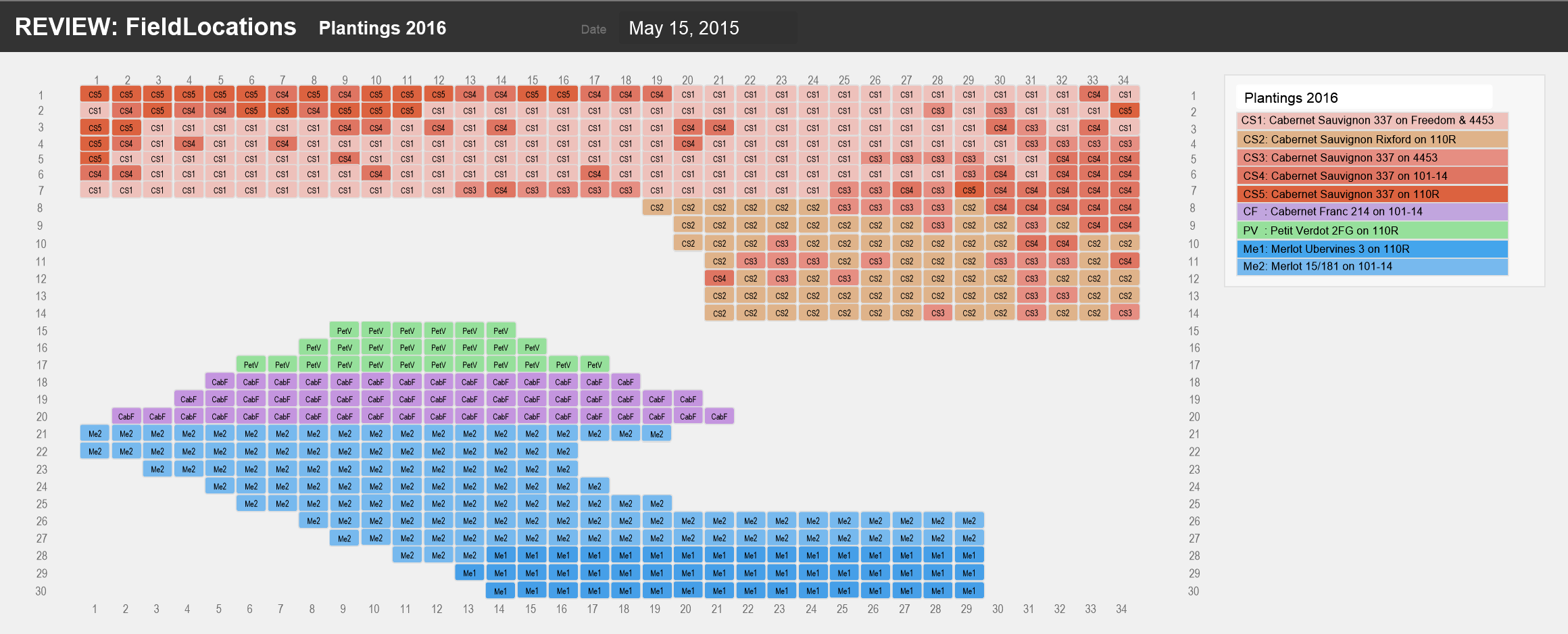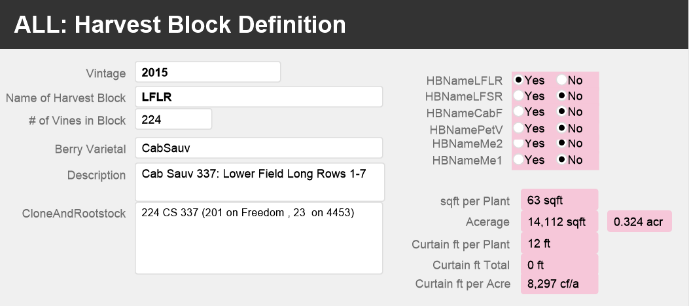Planting & Replanting
New vines are best planted in early spring, and for the first three years after that, they are managed not for fruit production but for growing their root systems and strengthening their trunks, arms, and cordons. Grapes can be harvested starting the end of the third season, but their quality is not optimal until the end of the 6th or 7th season. Because we lose vines due to diseases and destruction by animals, we need to add some new plantings every 4-5 years.
This page describes:
How we select rootstocks and vines and what we planted and replanted first in the Lower Field, then in the Upper Field
How we planted the vines and how we take care of them during the first three years.
Selecting Rootstocks & Vines
Ever since the phylloxera epidemic over a century ago, standard practice is to graft a grapevine selected for its fruit on a rootstock chosen for its resistance to pests and adaptability to soil conditions. Thus we need to choose combinations of a rootstock with a vine suitable to our climate, soil condition, and grape variety.
A good article on how to select rootstocks can be found here http://iv.ucdavis.edu/files/24347.pdf. A comprehensive list of available rootstock is at http://vintagenurseries.com/resources/rootstock-guide.pdf. A good discussion on rootstocks is at http://www.lodiwine.com/AWalkerRootstocks5-8-12.pdf.
A comprehensive list of grapevines registered in the U.S. can be found here: http://ngr.ucdavis.edu/varietylist.cfm. UC Davis runs Foundation Plant Services (http://fpms.ucdavis.edu/), a service that produces, tests, maintains and distributes virus and disease-tested plant material for propagation by nurseries.
The selection of grape varieties is large, but relatively few are widely used. Furthermore, the final rootstock/vine selection is often restricted by what is available at the nurseries nearby.
Lower Field: Ron Mosley planted 340 vines in July 1997. He, unfortunately, lost the original planting documents, so the following is from his memory as of 2013 and a comparison of anthocyanin concentrations in berries in 2015.
Some of the seven long rows in the southwest (34 plants each) were planted on “Freedom” roots with 337 cabernet clones; the other rows were planted on “4453” roots, also with 337 cabernet clones.
The seven short rows in the northeast (14-16 plants each) were planted on “110R” rootstock with “Dr. Emmet Rixford” cabernet clones. The Rixford clones have a lineage back to La Questa, a historic vineyard in the South Bay. They trace their history back to Margaux in Bordeaux and are currently propagated by Mount Eden Vineyards.
Due to gophers, which we failed to eliminate in time, we lost around 50 vines in 2006 & 2007. The lost spots were replanted in 2009 with 50 CabSauv vines clone 337 on 4453 roots. The following graphic shows the locations.
By 2014 more vines were lost due to Eutypa, gophers, and rototiller malfunctions, so we decided to initiate another significant replant in 2015 with cabernet clones 337 on 101-14 roots purchased (dormant bare roots) from Vintage Nurseries. When many of these bare root plantings failed due to false instructions from Vintage Nurseries, we needed to replant them with new green plants of clone 337 on 110R roots.
For the 2015 replanting, we modified the irrigation system to irrigate the new vines automatically every week.
Upper Field: In the spring of 2015, we planted grape varietals that complement Cabernet Sauvignon in typical Bordeaux blends. With advice from Ron Mosley and given availability at different nurseries, we settled on the following clone/rootstock combinations:
26 Cabernet Franc clone 214 on 101-14 roots from Mercier Groupe (dormant potted),
51 Petit Verdot clone 02 on 110R roots from Vintage Nurseries (dormant bare roots)
122 Merlot clone 15 on 101-14 roots from Vintage Nurseries (dormant bare roots), and
49 Merlot clone three on 110R roots “Ueber”-vines from Duarte Nurseries (green potted).
The green potted Merlot “Ueber”-vines from Duarte were planted in 5-gallon pots in spring 2014 and replanted in the upper field in April 2015. We received the bare roots in May, boxed in moist sawdust.
Planting and Growing first three years
The original instructions from Vintage Nurseries were: “The bare root vines are warmed up to bud-swell and planted in a 14” pre-irrigated hole. The graft union is set around 4” above soil level. Then, a mound of loose soil is built over the vine 1” above the tip of the vine. This mound protects the vine from drying out until the roots take hold. When green growth is showing, about two weeks later, the mound is removed, and a shelter tube is put over the vine for the remainder of the planting season”. Unfortunately, these instructions were wrong; 50% of the vines died! Vintage Nurseries provided replacements and new instructions: The bare root vines are acclimated for 2-3 weeks, then soaked for 4-6 hours in water before planting. No mound of dirt is needed for summer plantings; the plants are protected with a shelter tube from the getgo.
New vines need moist soil during the first summer, so we irrigate twice a week with 1 gallon/plant through the buried soaker hoses. Plants that struggle get another 1 gallon twice a week with a surface drip.
Data Management
Four tables in our database define and track the planting of vines:
PlantDefinitions defines which vine-rootstock combination we use
PlantingActions records which plant is planted or removed at a given location
FieldLocations records on a map which location holds a particular vine at a given date
HarvestBlockDefinitiion describes for each vintage how we delineate and describe harvest blocks.
The layout “ALL: Plant Definitions” shows the field we use to describe a vine. Here are screenshots of the layout with the field names and a table listing all the records.
The layout “ALL: PlantingActions” shows the fields we use to describe planting and removal locations. We use this table also to rename the plant and the block. This table has over 700 records, each telling when we planted a new vine and if it has already been replaced when we removed it. The second screenshot show only a part of the table.
The table FieldLocations shows the vineyard map and what exactly is planted where at given points in time. We also use this table to track fruit loads (see Winemaking section ). The following screenshots show the names fields (ALL: FieldLocations} and how we use the table to visualize the map and plantings on a particular date (REVIEW: FieldLocations)
The HarvestBlockDefinition table defines harvest blocks for each vintage. The following screenshots show the field names and, for example, the LFLR block for 2015.
Plantings and replantings are recorded as individual new entries in the PlantingActions table and, altogether, as an entry in the VinyardActions table under the caption “Plant Management.” Here is a screenshot of the “INPUT: VineyardActions” – Layout for the recording of the June 2009 replantings of 50 Cabernet Sauvignon vines in the lower vineyard
Previous page: Site Preparation
Top of page: Go
Next Page: Soil & Vineyard Floor Management
Last updated: April 25, 2021









